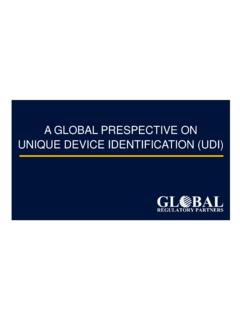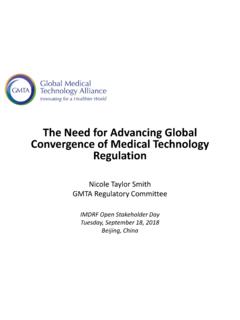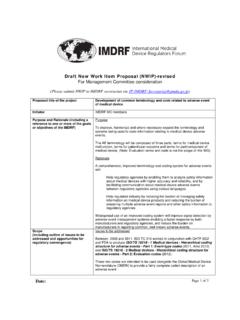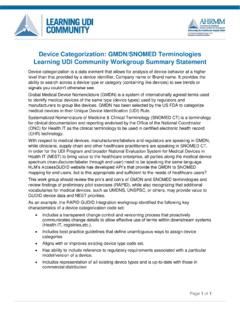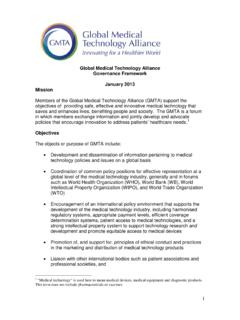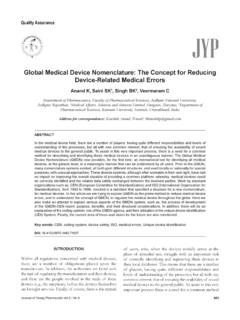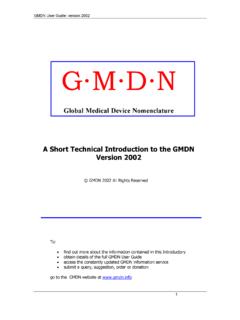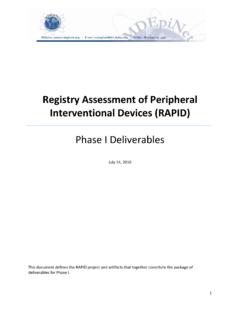Transcription of Guide to Label and Marking Compliance Medical Packaging
1 Page i Guide to Label and Marking Compliance Medical PackagingUnique Device Identification (UDI)LABELING& CODINGL&CPage ii Unique Device Identification Guide to Label and Marking ComplianceFor Medical Device Manufacturers Table of ContentsIntroduction ..1 What is UDI? ..1 Classification of Medical devices ..2 Steps Towards Compliance ..3 Compliance Guidelines ..4 AIDC - The Linear Barcode and the 2D DataMatrix ..6 Parts of the UDI ..7 Standard Date Format ..7 Standards Available for UDI Labeling ..7GS1 ( global Standard 1) and UDI ..8 HIBCC Standards for UDI ..10 About ICCBBA ..11 UDI at The Unit and Packaging Level ..12 The Label Design Software ..13 Printing The UDI - The Label or Direct Mark.
2 14 Thermal Transfer Label Materials ..15 UDI Database - GUDID ..16 Other Helpful Resources for FDA UDI ..17 Page 1 IntroductionPatient safety with regards to the identification of Medical devices , protection from counterfeit devices , and the ability to recall devices quickly and accurately has led to the development of the Unique Device Identification (UDI) system. The Food and Drug Administration (FDA) issued a final rule to establishing a system to adequately identify devices through distribution and use. The content in this ebook focuses on understanding UDI formation, identification labeling, and Marking at the required unit through Packaging is UDI? A UDI stands for Unique Device Identification.
3 It is a unique numeric or alphanumeric code that includes a device identifier, which is specific to a device model, and a production identifier. It includes the current production information for that specific device, such as the lot or batch number, the serial number and/or expiration UDI must appear on every device using a Label or direct Marking such as with ink jet or lasers, except where it is not feasible according to the FDA are the Benefits of UDI?When fully implemented, the UDI system will: Allow more accurate reporting, reviewing and analysis of adverse event reports so that problem devices can be identified and corrected quickly. Reduce Medical errors by giving health care professionals and others the ability to rapidly and precisely identify a device and obtain important information concerning the device s characteristics.
4 Provide a standardized identifier to allow manufacturers, distributors and healthcare facilities to better manage Medical device recalls. Provide a foundation for a global , secure distribution chain, helping to address counterfeiting and diversion and prepare for Medical emergencies. Lead to the development of a Medical device identification system that is recognized around the world. Enhance analysis of devices on the market by providing a standard and clear way to document device use in electronic health records, clinical information systems, claim data sources and registries. A more robust postmarket surveillance system can also be leveraged to support premarket approval or clearance of new devices and new uses of currently marketed UDI Label for a fictitious Medical device.
5 The Label contains information about the product name, its expiration date, reference and lot numbers, manufacturer information, bar code, and details about the itemPage 2 UDI AcronymsWhen reading the FDA s final ruling on UDI and working to meet Compliance regulations for UDI, you will come across acronyms that stand for terms related to the UDI mandate. If you are already working with identifying, labeling and tracking your products, you will most likely be familiar with many of the acronyms listed here. New users may want to refer to this Guide when learning to become familiar with these terms. Definitions can easily be found online or through your associated AcronymsMeaningDUNSD&B number used for the GUDIDUDIU nique Device IdentificationGLNG lobal Location Number GS1 GTING lobal Trade Item Number GS1 GMDNG lobal Medical Device NomenclatureGUDIDG lobal UDI DatebaseDIDevice IdentifierPIProduction IdentifierAIDCA utomatic Identification and Date CaptureGS1 The GS1 Standards OrganizationHIBCCH ealth Industry Business CommunicationICCBBAI nternational Council for Commonality in Blood Banking Automation.
6 Of Medical DevicesMedical devices are classified into three classes according to the amount of risk involved with the Medical Class I Medical device has little to no risk, such as a hand-held surgical instrument, elastic bandages, or examination gloves. This class of devices need to follow general FDA policies, such as registering the device, correctly branding and labeling the device, and proper manufacturing techniques. Class II Medical devices are the largest classification, and include devices such as X-ray machines, powered wheelchairs, infusion pump and surgical and acupuncture needles Class II devices pose a minimal risk. Such devices must follow general policy and special labeling, mandatory performance standards and post market surveillance.
7 Class III Medical devices have the strictest guidelines because they pose the greatest risk to patients Class III Medical devices must follow Class I and Class II guidelines but must also be pre-market approved by the FDA and a scientific review of the Medical device must be made prior to marketing. Class III Medical devices support or sustain human lives and include devices such as implanted pacemakers and heart 3 The Food and Drug Administration issued a final rule to establishing a system to adequately identify devices through distribution and use. Place UDI on the Label or Directly on Device The Label and device package of each Medical device must now include a UDI. This rule requires the Label of Medical devices to include a unique device identifier (UDI), except where the rule provides for an exception or alternative placement.
8 The UDI shall be on the Label of the device or directly marked on the device itself and requires that each UDI be provided in a plain-text version and in a form that uses automatic identification and data capture (AIDC) technology. Store the UDI in the UDID The labeler must submit product information concerning devices to FDA s GUDID, unless subject to an exception or alternative. The manufacturer is responsible for maintaining the accessibility of their UDI and the related information in the UDI the UDI The UDI code is a unique numeric or alphanumeric code that includes two parts: a device identifier (DI), which is specific to a device model, and a production identifier (PI), which includes the current production information for that specific device, such as the lot or batch number, the serial number and/or expiration are responsible for creating and maintaining the uniqueness of its Medical device UDI and shall not be altered.
9 Steps Towards ComplianceComplying with the UDI standard means manufacturers ( Labelers ) must assign a UDI-compliant code developed using globally accepted standards to their product, Label the products with the UDI appropriately, and then publish the data to the UDI database or GUDID ( global Unique Device Identification Database.)The Company is called The Labeler in the new requirements are: The unique identifier includes the lot or serial number if specified by FDA. The Label of a device bears a unique identifier, unless an alternative location is specified by the Food and Drug Administration (FDA) or unless an exception is made for a particular device or group of devices .
10 The unique identifier is able to identify the device through distribution and use by its Label , Marking , and can be cross referenced with the 4 Compliance GuidelinesThe FDA defined a phased in approach to Compliance depending upon the device s risk classification:Identify which of your devices must come into Compliance right now. The final rule is made, and if you do not have a UDI system in place within the time line specified by the FDA, you will not be able to sell your product. By 2014, Class III Medical devices must comply. By 2015, Class II and Class I implants and life-supporting or life-sustaining devices must comply By 2016, Class II items my comply By 2018, Class I and items that have not been assigned a class must be in that are manufactured and labeled before their Compliance date have an exception from the rule, which expires three years from the Compliance date.



